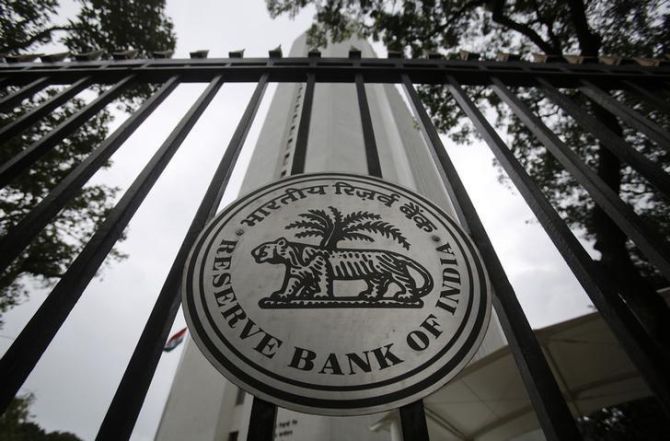 | « Back to article | Print this article |
By no means do economists see the Reserve Bank of India stop at just a 25-bp cut. Some of the economists such as Soumyakanti Ghosh of State Bank of India are of the firm view that rates have room to fall by a total of 75 bps in the current financial year, starting with 25 bps in the August 7 policy.

Economists and market participants expect at least a 25-basis point cut in policy rates in the August 7 monetary policy review -- and some more in the coming policies -- to tackle the growth slowdown.
Inflation concerns seem to be behind us till such time that commodity prices start firming up. In an environment of trade wars, where global growth has itself taken a hit, it is unlikely that commodities will be in much demand either.
Of the 15 economists and market players who participated in the poll, two predicted a 50-basis point cut, while the rest anticipated a rate reduction by 25 basis points (bps).
But by no means economists see the Reserve Bank of India (RBI) to stop at just a 25-bp cut.
Some of the economists such as Soumyakanti Ghosh of State Bank of India are of the firm view that rates have room to fall by a total of 75 bps in the current financial year, starting with 25 bps in the August 7 policy.
“We expect the RBI to cut by 25 bps on August 7. We also believe the rate cut could be in multiples of 25 bps. We are now in a synchronised rate-cutting cycle by central banks across the world, and this looks even different from 2008. There is also a pressing need for the central bank to define an equilibrium real interest rate,” Ghosh said.
Aditi Nayar, principal economist of ICRA, sees one rate cut of 25 bps, followed by a pause.
“An increasing risk to the already slowing global economy from the US-China trade dispute further increases the uncertainty. We see scope for a cumulative 50-bp rate cut in the months ahead, with 25 bps in the upcoming policy,” said Upasna Bhardwaj, chief economist of Kotak Mahindra Bank.
Even as the rate decision will be data dependent, the absence of hawkish Viral Acharya in the six-member monetary policy committee (MPC) could help gather a consensus on rate cuts.
Banks have started lowering their rates, starting with deposit rates, and this will lead to lending rate cuts in the coming days.
Abheek Barua, chief economist of HDFC Bank, expects a 25-bp rate cut now, and then another at a latter policy date.
“The critical factor now is the liquidity framework that the RBI might announce in the policy, or soon after the policy,” Barua said.
According to economists, the new framework would likely spell out clearly if the system would be in the liquidity surplus or deficit mode and what would be the factors that determine that. The RBI in a previous policy had said the present liquidity framework had become out of sync with the real situation on the ground.
Siddhartha Sanyal, newly appointed chief economist and head of research at Bandhan Bank, said he expected the central bank to lower policy rates by 50-75 bps in total, including 25 bps in August.
“Growth momentum remains subdued. Headline inflation stays low, with a markedly weak core inflation print. Erratic rains can potentially pose upside pressure on food inflation in the near term, but that will likely remain short-lived. Globally, central banks have turned more dovish in recent months,” Sanyal said.
Consumer Price Index (CPI) inflation stood at 3.18 per cent in June. The RBI tries to keep inflation under 4 per cent. Growth, however, is at around 7 per cent, below its potential.
“Based on a variety of activity indicators and a weakening global economic momentum, it is quite likely that domestic growth, especially over the first half of the year, would underperform the RBI’s estimates and as a result the slack in the economy would increase,” said Gaurav Kapur, chief economist of IndusInd Bank.
While inflation remains under control, “the need for more monetary stimulus to support growth is quite clear, even as past rate actions gradually translate into lower lending rates and help drive a recovery,” Kapur said.
Kapur, along with other economists, expects it would be important to ensure comfortable liquidity conditions to help improve the flow of credit and to help bank transmit the policy rate cuts.
The bond yields, meanwhile, have fully factored in a rate cut, and have fallen about 60 bps in July. According to Ramkamal Samanta, vice president, investment, at SUD Life Insurance, a 25-bp cut at this point would be desirable, “with a clear communication about the liquidity stance of the RBI”.
Apart from cutting rates and lowering growth forecasts, the RBI policy might announce some concrete steps for the NBFC segment as well, said Rupa Rege Nitsure, group chief economist of L&T Finance.
However, despite rate cuts, there is no guarantee that consumers could be made to buy goods, or companies to invest in new projects, economists fear.
“It remains to be seen how much rate cuts help in reviving demand in the economy,” said Devendra Pant, chief economist of India Ratings and Research.